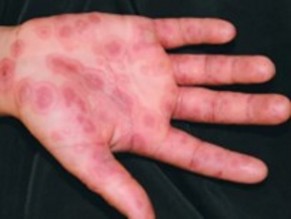Incidence: quite frequent. Inflammatory skin disease characterized by the appearance of raised, pink-red skin patches surrounded by a pale circle or a pink-red circle (cocarde image), and generally distributed symmetrically over the body. It is generally caused by a reaction to an infection, typically herpes simplex virus, more rarely mycoplasma (pneumonia), a vaccine, a drug or hepatitis C.
Characteristic signs: red patches with a cyanotic center (cocoon lesions) that appear suddenly on the palms and soles of the feet, arms and legs, face, and sometimes progressively all over the body. Lesions are sometimes painful. Pruritus is rare. Mouth ulcers are sometimes present.

Anesthetic implications:
fragile skin; mouth ulcers; sometimes: corticotherapy
References :
-
Updated: August 2023